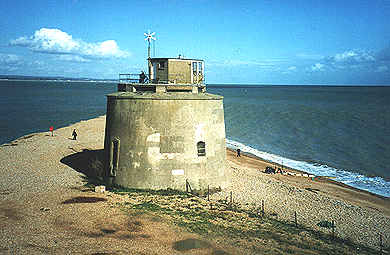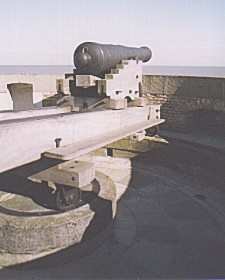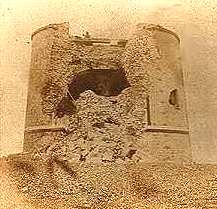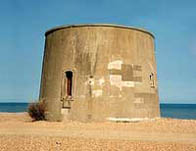|
MARTELLO TOWER - 1805 - 1812
|
|
HOME | BIOLOGY | FILMS | GEOGRAPHY | HISTORY | INDEX | MUSIC | THE BOAT | SOLAR BOATS | SPONSORS |
|
The Martello Towers were part of the same defence scheme as the Redoubt, 74 being built between Folkestone in Kent and Seaford, 12 miles west of Eastbourne. The name 'Martello' comes originally from a tower built on Mortella Point in San Fiorenzo Bay, Corsica, which in February 1794 held off an attack by two Royal Navy ships, inflicting heavy damage on one of them.
Only after a gun battery had landed and pounded the tower for two days, was the tower finally taken, and only because a lucky shot had set the tower on fire. The defence put up by the tower greatly impressed those who had tried to capture it, and after much debate and decision, Brigadier-General William Twiss surveyed the English coastline, and decided where similar towers should be built. 'Mortella' soon became corrupted to 'Martello' and the name was accepted as a universal term for any round defensive tower.
Each tower was made of about half a million bricks, and although they look round, they are in fact slightly eliptical. The walls were thicker on the side facing the sea, because that was where most enemy fire was expected to come from. The roundness and thickness of the walls was designed to deflect cannon balls, which tests proved they could not penetrate. A round brick pillar rose through the centre of the tower to support the roof, on which a cannon on a rotating gun carriage (the same as those used in the Redoubt) could fire in all directions.
Martello Tower No.66 by the Sovereign Harbour entrance
By 1803 Boulogne had become an enormous camp for a French Army of over 130,000 men and 22,000 landing boats, poised ready to invade Britain. The Royal Navy had also by then begun to blockade French ports to prevent the invasion force leaving French waters. However, some form of coastal defense system for England was needed in the light of French raids in Wales and Ireland.
The idea to erect towers along the English coast at this time was put forward by a Captain W.H. Ford of the Royal Engineers, who proposed a chain of square towers along the Kent and Sussex coast. Ford, however, was not the first to come up with this idea; in 1798, a Captain Reynolds had proposed a line of towers in similar positions to those that were begun seven years later.1 "...there are no Works that appear to me so likely (to prevent an enemy landing) as a Simple Tower of Brickwork defended by a Handful of Resolute Men."2The doorway to a Martello was halfway up the wall, making it easier to defend. A ladder was needed to enter, and this could be pulled up into the tower if need be. The ground floor of the tower was the magazine, where gunpowder, cannon balls and supplies were kept. Many towers had large rainwater tanks under the floor to store drinking water. As with the Redoubt, Martello Towers were designed to withstand a lengthy siege. Several towers, such as No. 73 in Eastbourne (the 'Wish Tower') were also protected by a moat.
The first floor was of wooden boards held up by the central pillar, and was where the garrison of 24 men and one officer lived. The living area was divided up into three or four rooms, one for the men, one almost the same size for the officer, and small store room, and the entrance hall, which had a trap door in the floor for access to the magazine. The two main rooms each had a fireplace for cooking and heating, and one of the two windows. In the mens quarters was a stone staircase built into the thickness of the wall, which led up to the roof.
Martello Tower canon
On the roof, the gun was mounted, protected by a parapet over which it fired. The towers were sited quite close together so that they could provide a cross-fire against enemy ships attempting to land troops. It was said that, in Pevensey Bay, a ship out to sea could have come under fire from fifteen towers at once.
Even before the towers had been built, gun batteries had been built along stretches of coastline, and Eastbourne had two such batteries at Langney Point. Known as West and East Langney Forts, these batteries contained six cannon, and with the line of towers and the Redoubt, made Eastbourne a heavily defended area. East Langney Fort was later known as 'Langney Redoubt'. Both forts were washed away by the sea, the western fort disappearing long before the eastern one started to be washed away in about 1910. Remains of East Langney Fort can still sometimes be seen today.
As Napoleon never tried to invade, the towers were not used for their intended purpose. Many of them were later used as Coast Guard stations in the fight against smuggling, which was rife all along the coast. Many fights on the beaches took place between smugglers and Coast Guards, resulting in several deaths on both sides.
By 1860, the Martello Towers were old-fashioned, as modern guns, such as the rifled breech-loading guns invented by Sir William Armstrong, were too advanced for the towers to stand up against adequately. Many towers by this time had fallen into the sea, or been demolished for building materials. Some towers were destroyed in military tests, such as experiments with gun cotton and explosive. Tower 71, which was near the Redoubt, was bombarded for two days in 1860 by some of Armstrong's new guns, in order to test them. The tower was devastated, and what was left was demolished. Tower 49 at Bexhill was later shot at with the older smoothbore cannon, to see if the Armstrong guns really were better. The rifled Armstrongs were found to be much the better weapons.
Martello Tower destroyed in 1860 tests
The walls of each tower were 13 feet thick on the seaward side and narrowed to 6 foot thick at the rear. A total of half a million bricks was required for each 30 foot high tower which as many bricks as were required to complete the Bell Harry Tower of Canterbury Cathedral. Not one of these forts ever fired a shot in anger.
These towers were never tested which is a great tribute. The best defence is that which deters attack and certainly the French regarded these little 'bulldogs' as a formidable barrier. With hindsight it appears that all these defences were, essentially, pointless since Nelson's victory at Trafalgar in October 1805 - at the very moment the construction of the Martello Tower system was getting under way - made a French invasion of Britain a virtual impossibility.
After
the destruction of his fleet at Trafalgar Napoleon went
on to win, in December 1805, the vastly important
victory at Austerlitz that confirmed the French as the
military and political masters of Europe. A French fleet
could be reconstructed and, as far as the British could
see, it was just a matter of time before the French were
again in a position to invade. It was not until 1812
when Napoleon and his allies were smashed in Russia that
the invasion of Britain was clearly beyond the French -
and in this year the construction of the chain of
Martello towers ceased. After the defeat of Napoleon at the Battle of Waterloo, there was little need for these towers in a defensive role but many were used to house the newly formed Coastguards to assist in the blockade that was started against smuggling in this area. Many retired soldiers and sailors, no longer required for active service, were taken on as Coastguards, normally with a preference for those men who were not native to the area. Today, all of the remaining 25 towers are classed as ancient monuments, many now being lived in or otherwise used.
If you want to know more about Martello Towers, then visit the website link: www.martello-towers.co.uk/ for a fuller history of every one of the 74 South Coast Martello
Towers - More Links:
|
|
This
website
is Copyright © 1999 & 2006 NJK. The bird |
|
AUTOMOTIVE | BLUEBIRD | ELECTRIC CARS | ELECTRIC CYCLES | SOLAR CARS |



